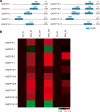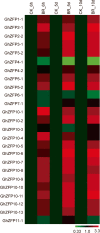Comprehensive analyses of ZFP gene family and characterization of expression profiles during plant hormone response in cotton
- PMID: 31337346
- PMCID: PMC6652020
- DOI: 10.1186/s12870-019-1932-6
Comprehensive analyses of ZFP gene family and characterization of expression profiles during plant hormone response in cotton
Abstract
Background: Zinc finger proteins (ZFPs) containing only a single zinc finger domain play important roles in the regulation of plant growth and development, as well as in biotic and abiotic stress responses. To date, the evolutionary history and functions of the ZFP gene family have not been identified in cotton.
Results: In this paper, we identified 29 ZFP genes in Gossypium hirsutum. This gene family was divided into seven subfamilies, 22 of which were distributed over 17 chromosomes. Bioinformatic analysis revealed that 20 GhZFP genes originated from whole genome duplications and two originated from dispersed duplication events, indicating that whole genome duplication is the main force in the expansion of the GhZFP gene family. Most GhZFP8 subfamily genes, except for GhZFP8-3, were highly expressed during fiber cell growth, and were induced by brassinosteroids in vitro. Furthermore, we found that a large number of GhZFP genes contained gibberellic acid responsive elements, auxin responsive elements, and E-box elements in their promoter regions. Exogenous application of these hormones significantly stimulated the expression of these genes.
Conclusions: Our findings reveal that GhZFP8 genes are involved in cotton fiber development and widely induced by auxin, gibberellin and BR, which provides a foundation for the identification of more downstream genes with potential roles in phytohormone stimuli, and a basis for breeding better cotton varieties in the future.
Keywords: Cotton; Expression patterns; Fiber development; Plant hormone; Zinc finger proteins.
Conflict of interest statement
The authors declare that they have no competing interests.
Figures







Similar articles
-
The PIN gene family in cotton (Gossypium hirsutum): genome-wide identification and gene expression analyses during root development and abiotic stress responses.BMC Genomics. 2017 Jul 3;18(1):507. doi: 10.1186/s12864-017-3901-5. BMC Genomics. 2017. PMID: 28673242 Free PMC article.
-
Genome-wide analysis of cotton GH3 subfamily II reveals functional divergence in fiber development, hormone response and plant architecture.BMC Plant Biol. 2018 Dec 12;18(1):350. doi: 10.1186/s12870-018-1545-5. BMC Plant Biol. 2018. PMID: 30541440 Free PMC article.
-
Characterization of bHLH/HLH genes that are involved in brassinosteroid (BR) signaling in fiber development of cotton (Gossypium hirsutum).BMC Plant Biol. 2018 Nov 27;18(1):304. doi: 10.1186/s12870-018-1523-y. BMC Plant Biol. 2018. PMID: 30482177 Free PMC article.
-
[Gibberellin signal transduction and cotton fiber molecular development].Yi Chuan. 2007 Mar;29(3):276-82. doi: 10.1360/yc-007-0276. Yi Chuan. 2007. PMID: 17369146 Review. Chinese.
-
A Pivotal Role of Hormones in Regulating Cotton Fiber Development.Front Plant Sci. 2019 Feb 14;10:87. doi: 10.3389/fpls.2019.00087. eCollection 2019. Front Plant Sci. 2019. PMID: 30838005 Free PMC article. Review.
Cited by
-
Zinc Finger Protein8 (GhZFP8) Regulates the Initiation of Trichomes in Arabidopsis and the Development of Fiber in Cotton.Plants (Basel). 2024 Feb 8;13(4):492. doi: 10.3390/plants13040492. Plants (Basel). 2024. PMID: 38498441 Free PMC article.
-
GhPIPLC2D promotes cotton fiber elongation by enhancing ethylene biosynthesis.iScience. 2021 Feb 17;24(3):102199. doi: 10.1016/j.isci.2021.102199. eCollection 2021 Mar 19. iScience. 2021. PMID: 33718844 Free PMC article.
-
Genome-wide identification and expression patterns analysis of the RPD3/HDA1 gene family in cotton.BMC Genomics. 2020 Sep 18;21(1):643. doi: 10.1186/s12864-020-07069-w. BMC Genomics. 2020. PMID: 32948145 Free PMC article.
-
Genome-Wide Identification and Expression Analysis Unveil the Involvement of the Cold Shock Protein (CSP) Gene Family in Cotton Hypothermia Stress.Plants (Basel). 2024 Feb 26;13(5):643. doi: 10.3390/plants13050643. Plants (Basel). 2024. PMID: 38475489 Free PMC article.
-
Genome-wide characterization of the WAK gene family and expression analysis under plant hormone treatment in cotton.BMC Genomics. 2021 Jan 28;22(1):85. doi: 10.1186/s12864-021-07378-8. BMC Genomics. 2021. PMID: 33509085 Free PMC article.
References
-
- Wendel JF, Cronn RC. Polyploidy and the evolutionary history of cotton. Adv Agron. 2003;78:139–186. doi: 10.1016/S0065-2113(02)78004-8. - DOI
-
- Gokani SJ, Thaker VS. Role of gibberellic acid in cotton fibre development. J Agric Sci. 2002;138:255–260. doi: 10.1017/S0021859602001934. - DOI
-
- Ueguchi-Tanaka M, Nakajima M, Katoh E, Ohmiya H, Asano K, Saji S, Xing H, Ashikari M, Kitano H, Yamaguchi I, Matsuoka M. Molecular interactions of a soluble gibberellin receptor, GID1, with a rice DELLA protein, SLR1, and gibberellin. Plant Cell. 2007;19:2140–2155. doi: 10.1105/tpc.106.043729. - DOI - PMC - PubMed
MeSH terms
Substances
Grants and funding
LinkOut - more resources
Full Text Sources
Other Literature Sources

